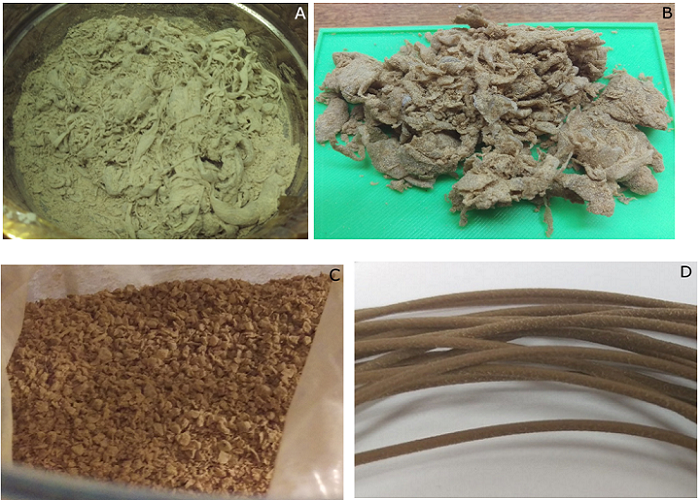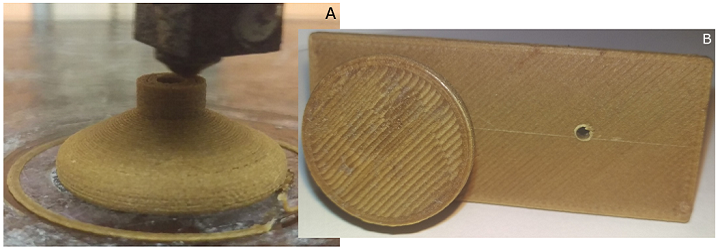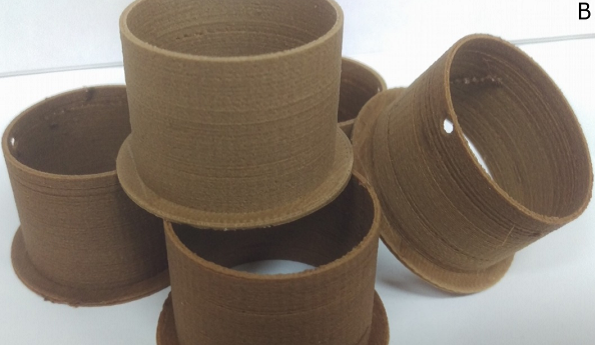H and H 3D plastics launch new industrial sized filament spools
Michigan Tech scientists write recommendations for greener 3D printing
The New Raw launches zero waste lab for recycled 3D printed furniture
Michigan Tech Researchers Recycle Wood Furniture Waste into Composite 3D Printing Material

A) PLA during mechanical mixing with wood-waste powder, B) PLA and wood-waste powder-based WPC after mixing and cooling to room temperature, C) chipped WPC, and D) homogeneous WPC material after first pass through recyclebot.
From artwork, instruments, and boats to gear shift knobs, cell phone accessories, and even 3D printers, wood has been used often as a 3D printing material. It’s a valuable renewable resource that stores carbon and is easily recycled, so why wouldn’t we think to use it in 3D printing projects?
 A trio of researchers from Michigan Technological University recently published a paper, titled “Wood Furniture Waste-Based Recycled 3-D Printing Filament,” that looks to see how viable a solution it is to use wood furniture waste, upcycled into a wood polymer composite (WPC) material, as a 3D printing feedstock for building furniture.
A trio of researchers from Michigan Technological University recently published a paper, titled “Wood Furniture Waste-Based Recycled 3-D Printing Filament,” that looks to see how viable a solution it is to use wood furniture waste, upcycled into a wood polymer composite (WPC) material, as a 3D printing feedstock for building furniture.
The abstract reads, “The Michigan furniture industry produces >150 tons/day of wood-based waste, which can be upcycled into a wood polymer composite (WPC). This study investigates the viability of using furniture waste as a feedstock for 3-D printer filament to produce furniture components. The process involves: grinding/milling board scraps made of both LDF/MDF/LDF and melamine/particleboard/paper impregnated with phenolic resins; pre-mixing wood-based powder with the biopolymer poly lactic acid (PLA), extruding twice through open-source recyclebots to fabricate homogeneous 3-D printable WPC filament, and printing with open source FFF-based 3-D printers. The results indicate there is a significant opportunity for waste-based composite WPCs to be used as 3-D printing filament.”
While a lot of wood is wasted by burning it, it may be better to upcycle it into WPCs, which contain a wood component in particle form inside a polymer matrix. These materials can help lower costs and environmental impact, as well as offer a greater performance.

A) 0.15 mm layer height drawer knob being 3D printed with a screw hole for attachment. B) Completed drawer knob fully attached on left of wood block with example pre-printed hole on right of block, 30wt% wood furniture waste.
“There is a wide range of modification techniques for wood either involving active modifications such as thermal or chemical treatments, or passive modification, which changes the physical properties but not the biochemical structure,” the researchers wrote. “However, WPCs still have limitations due to production methods, such as producing waste material or orientation reliant fabrication, which may be alleviated with alternative manufacturing techniques such as additive manufacturing.”
While lots of PLA composite manufacturers are already in the market to make virgin, wood-based 3D printing filaments, the Michigan Tech study investigated using wood furniture waste as a 3D printing feedstock for WPC filament, which could then be used to make new furniture components.
“The process uses grinding and milling of two furniture waste materials – boards scraps made of both LDF/MDF/LDF (where LDF is light density fill and MDF is medium density fill) and melamine/particleboard/paper impregnated with phenolic resins. A pre-mixing process is used for the resultant wood-based powder with PLA pellets,” the researchers wrote. “This material is extruded twice through an open source recyclebot to fabricate homogeneous 3-D printable filament in volume fractions of wood:PLA from 10:100 to 40:100. The filament is tested in an open source FFF-based industrial 3-D printer. The results are presented and discussed to analyze the opportunity for waste based composite filament production.”

Surface contours of a personalized drawer handle with the Herman Miller emblem. A coloration change from the outside to the center is shown due to induced temperature changes during printing to provide a tree ring.
The team received wood-based waste material, in both sawdust and bulk form, from several furniture manufacturing companies, and completed some important steps to turn the wood waste into WPCs for 3D printing filament:
- Size reduction from macro- and meso-scale to micro-scale
- Mix fine wood-based filler material with matrix polymer
- Extrude feed material into filament of homogeneous thickness and density
Then, the material was loaded into a delta RepRap 3D printer, as well as an open source Re:3D Gigabot 3D printer, to make a high-resolution drawer knob that was “attached to a printed wood block using a wood screw threaded through a pre-printed hole.”
“The wood screw was easily twisted through both objects with a Phillips screwdriver and the resulting connection withstood normal forces expected in everyday use. Additionally due to the flexibility of 3-D printing orientations a unique or personalized surfaces may be printed onto objects,” the researchers wrote.
“This is shown through the particular geometries or print directions which may be modified directly by altering gcode, or more conveniently by changing parameters in slicer programs. This enables mass-scale personalization of not only furniture components with wood, but any 3D printed part using recycled waste-based plastic composites.”
Once an optimized 3D printing profile was obtained, the recycled wood furniture waste-based WPC filament was able to produce parts without too many errors. However, there was a greater frequency of filament blockages and nozzle clogging with this material, when compared to pure PLA.
“This study has demonstrated a technically viable methodology of upcycling furniture wood waste into usable 3-D printable parts for the furniture industry,” the researchers concluded. “By mixing PLA pellets and recycled wood waste material filament was produced with a diameter size of 1.65±0.10 mm and used to print a small variety of test parts. This method while developed in the lab may be scaled up to meet industry needs as the process steps are uncomplicated. Small batches of 40wt% wood were created, but showed reduced repeatability, while batches of 30wt% wood showed the most promise with ease of use.”
The researchers wrote that further work on creating waste-based WPC filament should include quantifying the material’s mechanical properties after the first cycle, and then comparing it to other materials, such as pure PLA and modified wood fiber powder. Additionally, industrial equipment and grouped 3D printing nozzles should be evaluated in terms of scaling up the process.
Co-authors of the paper are Adam M. Pringle, Mark Rudnicki, and Joshua Pearce.
Discuss this and other 3D printing topics at 3DPrintBoard.com or share your thoughts below.
Los Angeles: Greneker Explores the Challenges of 3D Printing Their Mannequins
3D printing has changed the world of how we create today in so many ways. Allowing for self-sustainability in innovation, everyone from the home hobbyist entrenched in DIY to the engineer working for an automotive company can make designs, objects, prototypes—and so much more—even houses. Many are newer to the technology and may be working on ideas that are completely new and extremely challenging.
That was the case for the Greneker team, headquartered in Los Angeles. Innovators since 1934, Greneker has always been known for their novel techniques in creating mannequins. 3D printing is a new endeavor for them though.
“When I started with this business, we would get together as a group, we would look at the trends in the marketplace, and we would develop a line based on what we saw happening in the marketplace at that time,” said Steve Beckman, President & COO of Greneker.
 Creating the mannequin line was indeed a major trial, but the team is used to taking on difficult missions in their work.
Creating the mannequin line was indeed a major trial, but the team is used to taking on difficult missions in their work.
“That was done with clay sculpting, so we would start with armatures and clay, go through the process ourselves, create an entire line of mannequins, and really just kind of rolled the dice and hope that it would sell to that market,” said Beckman.
The Greneker team began doing a lot of custom work, and for big clients too, like Under Armour and adidas.
“It was a very long process to develop a line of custom mannequins,” Beckman said. “We would have to spend a great deal of time upfront with a client trying to figure out what they were looking for, what the poses were, what the dimensions were, what sizes these pieces were. The armatures would be set up by hand, the sculpting would be done by hand in clay. It would require several visits of the client on premises before we got an approval to move into the molding process to begin production.”
On working with athletic apparel manufacturers:
“The poses are either accurate or they’re inaccurate,” Beckman said. “If you try and put a golf mannequin in a golf shop and he is not in the proper position, the mannequin will be ripped apart by patrons.”
They streamlined the creating and 3D printing process as they learned more about what worked.
“We started to look at digital as a way of creating these pieces, and creating them precisely and accurately,” Beckman recounted. “We’ve now moved from clay sculpting to everything being 3D printed, which has helped us in a myriad of ways.”
3D printing at Greneker began with a CubeX, and then other small 3D printers. After that, they graduated to the re:3D Gigabot 3D printer, which has provided advanced solutions in fire stations, veterinary practices, and many more impactful applications.
“We selected the printer based on, again, the human body,” Beckman explained. “We’re a mannequin manufacturer. We wanted larger printers to be able to print torsos and legs.”
“Before 3D printing, it would’ve been just unthinkable to make a mannequin in a day,” said Daniel Stocks, senior sculptor at Greneker. “Now it’s actually possible.”
Speed in creating the mannequins is one of the greatest benefits Greneker experiences in 3D printing, along with the digital process overall.
“We save time throughout the entire process,” said Beckman. “Instead of having clients visit, we can have video conferencing now, which accelerates the initial consultation period greatly. The client can sit on the other end – whether they’re across the country or across the world – and in real time we can make those changes and those tweaks to make these pieces exactly what they’re looking for.”
Sculpting mannequins can be challenging, but with 3D printing manufacturers are able to work with new creations easily—and without the physical workout.
“With 3D printing, we take the digital model and we’ll produce a scaled model, usually about 18 inches tall, and then we can send that to the clients,” said Beckman. “They can make sure that all the measurements fit where they like and that the posing is what it needs to be in. Once we get the sign-off at that point, then we produce a full-scale 3D print.
“With this new process, the model goes in front of everybody, so it’s there for everyone to look at. You get a much, much tighter buy-in much more quickly.”
 Needless to say, at Greneker, they have a lot more tools to work with than they did previously—and they are making the most of it.
Needless to say, at Greneker, they have a lot more tools to work with than they did previously—and they are making the most of it.
“If I have a large project and I have three sculptors working on it, because it’s three sets of hands, it may not look identical,” Beckman explained. “With the digital design, we don’t have to worry about that. The design is the design and you can move it, change it, scale it, but it’s always the base design and it’s always obvious what it is, no question.”
The added Greneker goal now is to be faster and more cost-effective in development.
“The marketplace is requiring speed to market. Everything has got to be done sooner rather than later,” Beckman explained. “When we would sculpt and create a new line by hand, the process could take upwards of six months in preproduction. In 3D printing, now we’ve reduced that process to where it can be as short as just a few weeks.
“Right now, we’ve just finished realizing our first set of goals with 3D printing. Our future goals: we’re going to bring in as many printers as it takes to be the absolute fastest to market as we can be. We want to stay ahead of our competition.”
You can read more about Greneker and their innovative projects here.
What do you think of this news? Let us know your thoughts; join the discussion of this and other 3D printing topics at 3DPrintBoard.com or share your thoughts below.
[Source / Images: re:3D]



